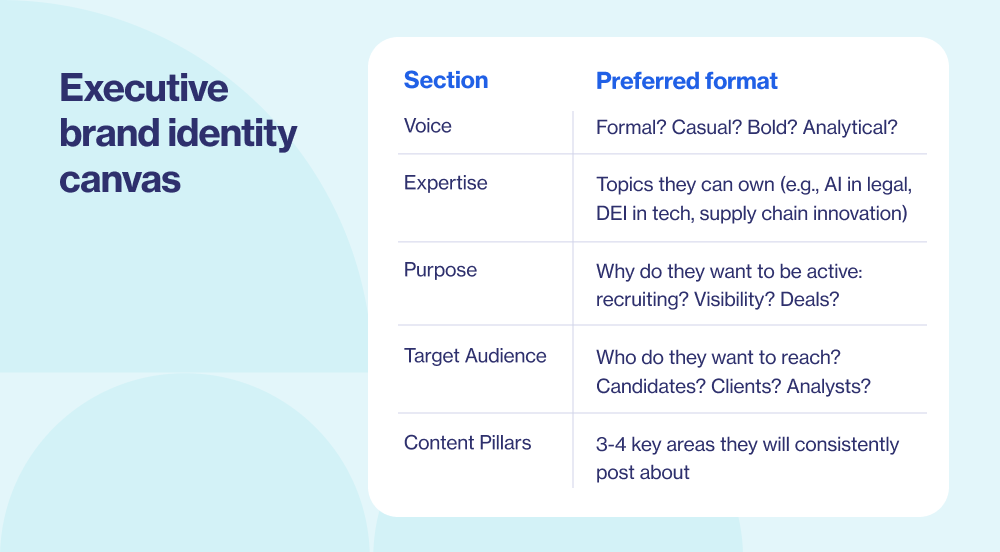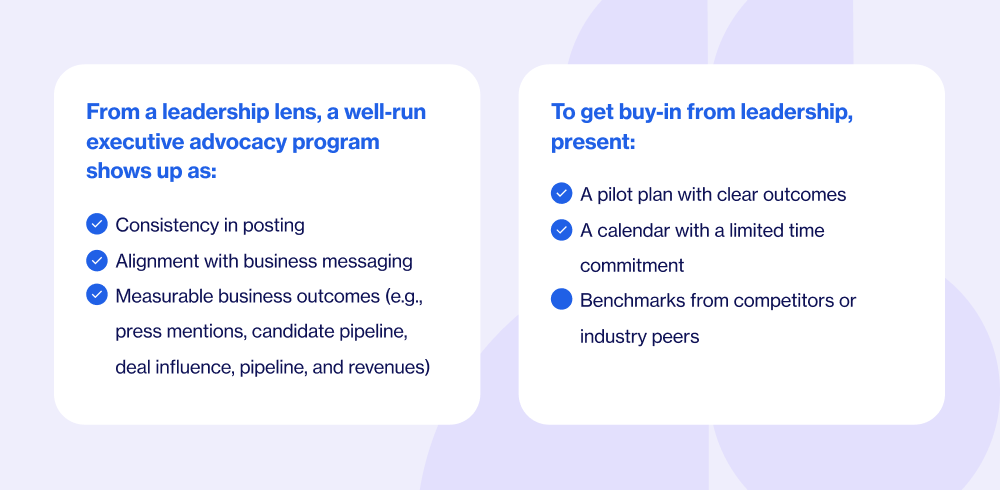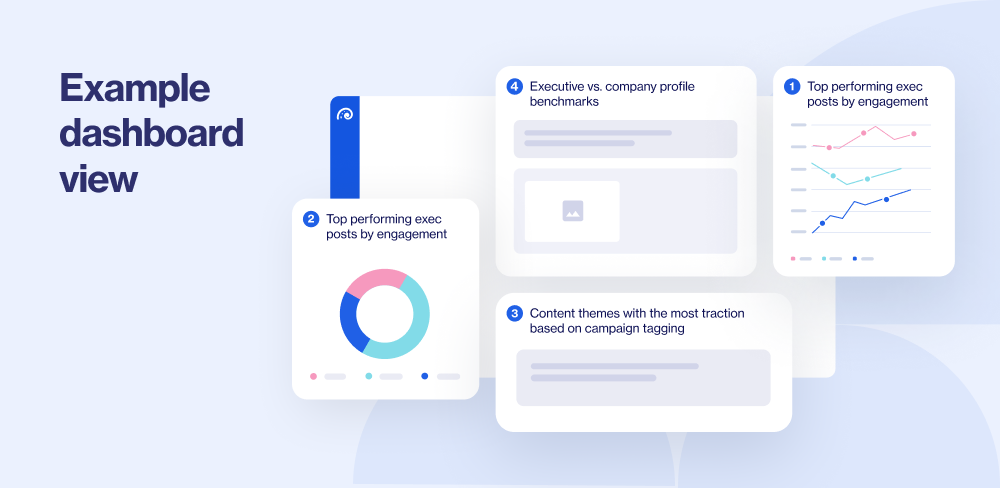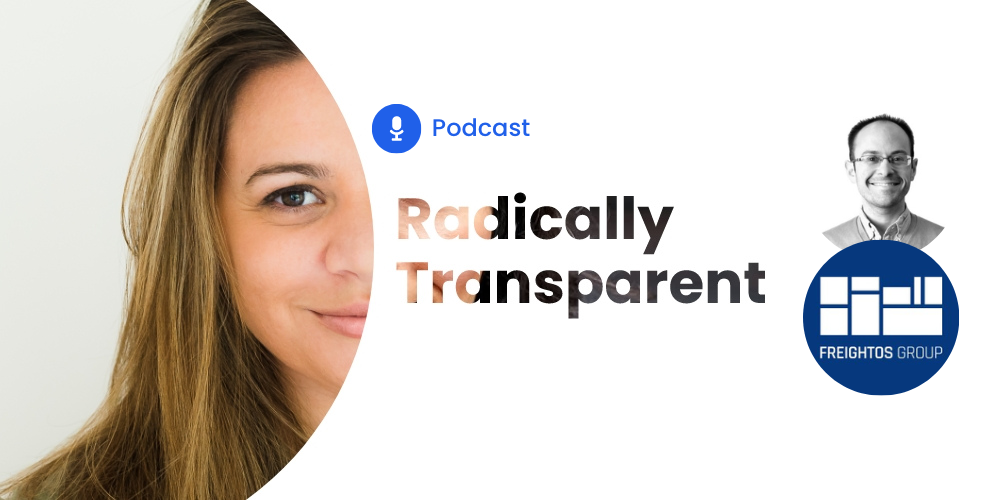A social media manager’s guide to executive advocacy on LinkedIn

Table of contents
- 1. Why executive advocacy on LinkedIn drives business results
- 2. Building executive brands from scratch with a strategy-first approach
- 3. How to get executive buy-in with the right pitch and support
- 4. Creating impactful content with or without ghostwriting
- 5. How to sustain momentum in your executive advocacy program
- 6. The most important metrics to measure executive advocacy success
- 7. Tools that help you manage and scale executive advocacy
- 8. Best-in-class examples of executive advocacy in action
- 9. Final thoughts on starting small and scaling strategically
1. Why executive advocacy on LinkedIn drives business results
In B2B, people tend to trust individuals more than brands. That makes executive advocacy one of the most powerful tools in a social media manager’s toolbox. Executive advocacy amplifies authority, credibility, and influence. When executives speak, people listen, and when done right, their voices can attract talent, drive pipeline and sales, and shape brand perception.
Based on the Edelman-LinkedIn B2B Thought Leadership Impact Report, winning B2B deals today takes more than a great product or flashy campaign; it takes influence in places sales and marketing don’t always reach. Nearly 40% of B2B deals stall due to internal misalignment among buying groups, and a big reason is the rise of hidden buyers who are influential stakeholders who rarely speak with sales but quietly shape decisions behind the scenes.
These decision-makers are far from passive. 63% of them spend over an hour each week consuming thought leadership, and 95% say strong thought leadership makes them more receptive to sales and marketing outreach. Even more compelling, 35% say a C-suite executive’s endorsement of a vendor’s thought leadership influenced their consideration.
Executive advocacy on LinkedIn isn’t just brand building, it’s deal-winning. When your leaders consistently show up with bold, human insights, they earn trust, spark interest, and mobilize internal champions who help get your proposal over the finish line.
Executive advocacy isn’t just brand advocacy; it’s brand leadership.
2. Building executive brands from scratch with a strategy-first approach
Before any post goes live, start with a strategy. For each of your executives, break down how they want to be perceived in the following categories.
Executive brand identity canvas:

LinkedIn profile optimization checklist
- Headshot that aligns with brand tone
- Headline that communicates role + passion (e.g., “CMO | Driving growth through customer obsession”)
- Custom URL (linkedin.com/in/firstname-lastname)
- Featured section with thought leadership
- Summary in first person with a clear POV
- Past roles that include achievements
3. How to get executive buy-in with the right pitch and support
How to pitch the value:
“Your voice can humanize the company.”
“Your peers are doing it, and so are our competitors.”
“You can grow your influence, support your team, and attract top talent.”
“You can impact sales and revenue for our company with your social activity.”
Common concerns and how to address them:
| Concern | How to respond |
| I don’t have time. | We’ll make it easy with ghostwriting and approvals. Just 15 minutes/week. |
| I’m not a writer. | You don’t need to be. We just need your ideas and voice. |
| Does it actually work? | Let me show you examples of execs whose posts led to deals and media mentions. |
Tip: Conduct a 15-minute personal consultation with each executive to review their goals, interests, and concerns.

4. Creating impactful content with or without ghostwriting
There are two tracks to consider based on the relevant executives:
Full-service ghostwriting and a hybrid collaboration.
Some executives will need or expect ghostwriting of their posts to include being active and posting or commenting on their behalf on social media.
In contrast, some executives will post themselves directly on the social platform or via an employee advocacy platform they can use after being provided with relevant written content.

Executive content briefing template
- Key messages for this quarter
- Preferred tone and style
- Content themes and examples
- CTA preferences (e.g., “DM me,” “Join the conversation”)
Build an approval process. See which approval workflow is the quickest between the ghostwriter and the executives for final sign-off before publishing. Usually, trust is built, and after understanding their point of view and their tone of voice, content suggestions require minimal revisions and are very quick.
5. How to sustain momentum in your executive advocacy program
Once you’ve launched, consistency is key. Here’s how to keep the wheels turning.
Monthly executive advocacy calendar (template)
| Week | Content Type | Owner | Status |
| Week 1 | Industry POV | Ghostwriter | Scheduled |
| Week 2 | Culture/Leadership | Exec | Drafted |
| Week 3 | Amplified company post | Exec | Shared |
| Week 4 | Video | Ghostwriter | Editing |
Ongoing engagement ideas
- Quarterly performance reviews
- Tagging execs in company posts
- Featuring their posts in internal newsletters
- Reposting their LinkedIn posts on Oktopost’s Advocacy Board to boost their engagement.
- Onboarding them to be part of the company employee advocacy and building an exec-only leaderboard for friendly exec-level gamification. (Measuring engagement and impact between CMO, CFO, CPO, or CRO can always help increase motivation.)
6. The most important metrics to measure executive advocacy success
Metrics to track
| Category | Metric |
| Reach | Followers gained, impressions |
| Engagement | Likes, comments, reshares |
| Influence | Clicks, mentions, tags, DMs |
| Business impact | Leads influenced, PR pickups, hiring referrals |
Use Oktopost to:
- Link executive LinkedIn profiles and publish directly from the Oktopost platform
- Compare the performance of company, executive, and employee profiles
- LinkedIn profile analytics are available within Oktopost’s Social BI tool. This enables understanding, scaling, and proving the impact of executive visibility on LinkedIn.
With the data from LinkedIn’s connectors to Oktopost, you can
- Track executive follower growth post by post, week by week, and directly attribute that growth to marketing efforts and results.
- Measure social content performance like video views, unique viewers, and watch time to better understand what kind of content works best.
- Analyze engagement at the post-level, including impressions, reach, and engagement metrics, such as reactions, reposts, and comments.
Example dashboard view
- Top performing exec posts by engagement
- Number of leads driven per executive
- Content themes with the most traction based on campaign tagging
- Executive vs. company profile benchmarks

7. Tools that help you manage and scale executive advocacy

Want to see how Oktopost supports executive advocacy? Request a demo here.
8. Best-in-class examples of executive advocacy in action
To give you an industry-spanning view of executive advocacy in action, here are real examples from Tech, Legal, Financial Services, and SaaS, including the types of content formats these leaders often use.
Example 1: Daniel Kushner, CEO & Co-founder at Oktopost
View profile
Shares product innovation, marketing strategy, and brand growth posts, often highlighting the Oktopost team and customers.
Example 2: Nick Mehta, CEO at Gainsight
View profile
Known for candid leadership posts that blend personal reflection with professional insight. Regularly drives conversations around customer success and culture.
Example 3: Chris Walker, CEO at Passetto
View profile
A master of strategic B2B marketing insights, he posts bold, thought-provoking takes that spark high engagement and reshape industry norms.
Example 4: Randi Zuckerberg, CEO at Zuckerberg Media
View profile
Blends professional storytelling with approachable lifestyle content to drive personal brand and community engagement.
Example 5: Tamar Yehoshua, Former CPO at Slack
View profile
Uses her platform to highlight product vision, inclusive leadership, and her journey as a senior woman in tech.
Example 6: Steve Poor, Chair Emeritus at Seyfarth Shaw LLP
View profile
A standout in the legal field, Steve regularly shares long-form reflections, blog-style posts, and articles on legal innovation, DEI, and firm culture, featuring a post format that combines long-form articles with leadership commentary.
Example 7: Jason Lemkin, Founder at SaaStr
View profile
Known for punchy, insight-packed posts about SaaS growth and founder challenges. Post format: Tactical micro-posts, engagement questions, data drops.
Example 8: Erica Keswin, Workplace Strategist & Author
View profile
Blends executive coaching with brand credibility. She often shares leadership frameworks and behind-the-scenes content from speaking engagements.
Post format: Personal storytelling + visual content. Shares regulatory updates with commentary, highlights team wins, and social causes.
Bonus: Read about executive-led brand takeovers in this
Oktopost blog
9. Final thoughts on starting small and scaling strategically
Executive advocacy is most effective when it’s consistent, aligned, and authentic. Don’t try to make execs sound like marketing; instead, amplify their unique perspectives. Start small. Pick one champion. Track results. And when it clicks, scale up.
Leadership buy-in, practical workflows, and strategic use of AI (for ideation and scaling, not replacing voice) can make advocacy programs achievable even for small teams. When leaders consistently show up, it inspires a ripple that motivates other employee advocacy, creates interest in joining the company, and fosters familiarity with the brand and the company.
Remember: brands that let their leaders lead on social are more relatable.
Download the PDF for an additional appendix with the following templates.
- Executive content brief template
- LinkedIn post types cheat sheet
- Exec onboarding email template
- Sample ghostwriting agreement
Download and share with your team
A social media manager’s guide to executive advocacy on LinkedIn



